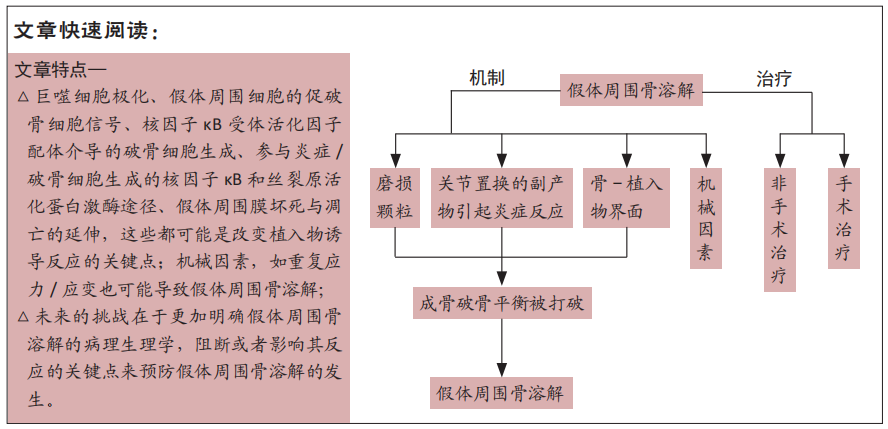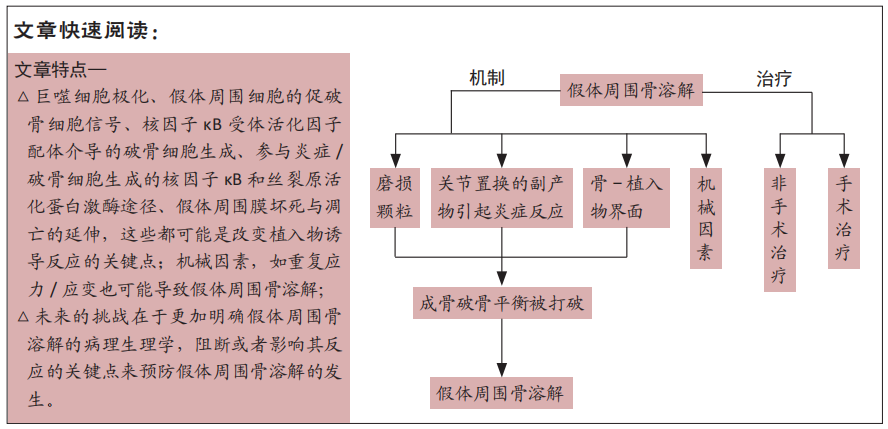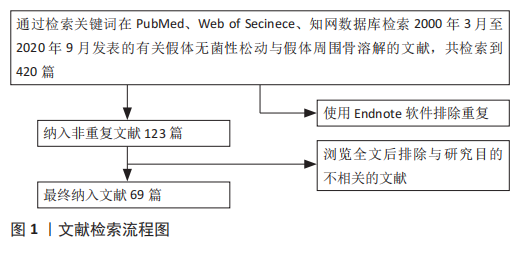[1] 蒋营军,吴连国. 人工关节置换术后磨损颗粒与假体周围骨溶解的研究进展[J]. 中国骨伤,2016,29(10):968-972.
[2] LIAO L, LIN Y, LIU Q, et al. Cepharanthine ameliorates titanium particle-induced osteolysis by inhibiting osteoclastogenesis and modulating OPG/RANKL ratio in a murine model. Biochem Biophys Res Commun. 2019;517(3):407-412.
[3] DYSKOVA T, KRIEGOVA E, SLOBODOVA Z, et al. Inflammation time-axis in aseptic loosening of total knee arthroplasty: A preliminary study. PLoS One. 2019;14(8):e221056.
[4] GALLO J, VACULOVA J, GOODMAN SB, et al. Contributions of human tissue analysis to understanding the mechanisms of loosening and osteolysis in total hip replacement. Acta Biomater. 2014;10(6): 2354-2366.
[5] GÜLER-YÜKSEL M, HOES JN, BULTINK IEM, et al. Glucocorticoids, Inflammation and Bone. Calcif Tissue Int. 2018;102(5):592-606.
[6] GOODMAN SB, GALLO J, GIBON E, et al. Diagnosis and management of implant debris-associated inflammation. Expert Rev Med Devices. 2020;17(1):41-56.
[7] ZHAO B. Does TNF Promote or Restrain Osteoclastogenesis and Inflammatory Bone Resorption? Crit Rev Immunol. 2018;38(4): 253-261.
[8] ZHENG W, GU X, HU D, et al. Co-culture with synovial tissue in patients with rheumatoid arthritis suppress cell proliferation by regulating MAPK pathway in osteoblasts. Am J Transl Res. 2019;11(6):3317-3327.
[9] EL-ADAWI H, DENG L, TRAMONTANO A, et al. The functional role of the JAK-STAT pathway in post-infarction remodeling. Cardiovasc Res. 2003;57(1):129-138.
[10] GONG T, LIU L, JIANG W, et al. DAMP-sensing receptors in sterile inflammation and inflammatory diseases. Nat Rev Immunol. 2020; 20(2):95-112.
[11] MARLA JS, LAUREN JJ, JAVAD P, et al. The Role of Oxidative Stress in Aseptic Loosening of Total Hip Arthroplasties. J Arthroplasty. 2014; 29(4):843-849.
[12] TAIWO SA, CHAEKYUN K. Reactive Oxygen Species in Osteoclast Differentiation and Possible Pharmaceutical Targets of ROS-Mediated Osteoclast Diseases. Int J Mol Sci. 2019;20(14):3576.
[13] MARMOTTI A, MESSINA D, CYKOWSKA A, et al. Periprosthetic osteolysis: a narrative review. J Biol Regul Homeost Agents. 2020; 34(4 Suppl 3):405-417.
[14] JAMSEN E, PAJARINEN J, LIN TH, et al. Effect of Aging on the Macrophage Response to Titanium Particles. J Orthop Res. 2020;38(2): 405-416.
[15] JIANG J, JIA T, GONG W, et al. Macrophage Polarization in IL-10 Treatment of Particle-Induced Inflammation and Osteolysis. Am J Pathol. 2016;186(1):57-66.
[16] 巩栋,甄平,王荣. 巨噬细胞极化在假体周围骨溶解中的作用:研究现状和进展[J]. 中国组织工程研究,2018,22(7):1120-1125.
[17] CHRISTIANSEN RJ, MÜNCH HJ, BONEFELD CM, et al. Cytokine Profile in Patients with Aseptic Loosening of Total Hip Replacements and Its Relation to Metal Release and Metal Allergy. J Clin Med. 2019;8(8):1259.
[18] VACULOVÁ J, HURNÍK P, GALLO J, et al. Immunohistochemical Detection of Mast and Dendritic Cells in Periprosthetic Tissues of Aseptically Loosened Total Prostheses. Acta Chir Orthop Traumatol Cech. 2018; 85(5):351-358.
[19] JONITZ-HEINCKE A, LOCHNER K, SCHULZE C, et al. Contribution of human osteoblasts and macrophages to bone matrix degradationand proinflammatory cytokine release after exposure to abrasive endoprostheticwear particles. Mol Med Rep. 2016;14(2):1491-1500.
[20] LIAO L, LIN Y, LIU Q, et al. Cepharanthine ameliorates titanium particle-induced osteolysis by inhibiting osteoclastogenesis and modulating OPG/RANKL ratio in a murine model. Biochem Biophys Res Commun. 2019;517(3):407-412.
[21] KOEHLER MI, HARTMANN ES, SCHLUESSEL S, et al. Impact of Periprosthetic Fibroblast-Like Cells on Osteoclastogenesis in Co-Culture with Peripheral Blood Mononuclear Cells Varies Depending on Culture System. Int J Mol Sci. 2019;20(10):2583.
[22] CHOVATIYA R, MEDZHITOV R. Stress, inflammation, and defense of homeostasis. Mol Cell. 2014;54(2):281-288.
[23] DYSKOVA T, KRIEGOVA E, SLOBODOVA Z, et al. Inflammation time-axis in aseptic loosening of total knee arthroplasty: A preliminary study. PLoS One. 2019;14(8):e221056.
[24] MISHRA PK, PALMA M, BUECHEL B, et al. Sterile particle-induced inflammation is mediated by macrophages releasing IL-33 through a Bruton’s tyrosine kinase-dependent pathway. Nat Mater. 2019;18(3): 289-297.
[25] 刘国印,王瑞,赵建宁. MicroRNA在无菌性松动中的研究进展[J]. 中国骨伤,2014,27(3):232-236.
[26] YUN Z, PENG HZ, WANG W, et al. A20 inhibits the release of inflammatory cytokines by suppressing the activation of the nuclear factor-kappa B pathway in osteoarthritic fibroblast-like synoviocytes. Biochem Biophys Res Commun. 2019;508(3):877-881.
[27] MEDIERO A, WILDER T, SHAH L, et al. Adenosine A2A receptor (A2AR) stimulation modulates expression of semaphorins 4D and 3A, regulators of bone homeostasis. FASEB J. 2018;32(7):3487-3501.
[28] YAN L, LU L, HU F, et al. Piceatannol attenuates RANKL-induced osteoclast differentiation and bone resorption by suppressing MAPK, NF-kappaB and AKT signalling pathways and promotes Caspase3-mediated apoptosis of mature osteoclasts. R Soc Open Sci. 2019;6(6): 190360.
[29] PARK JH, LEE NK, LEE SY. Current Understanding of RANK Signaling in Osteoclast Differentiation and Maturation. Mol Cells. 2017;40(10): 706-713.
[30] CHEN Y, AIKEN A, SAW S, et al. TIMP Loss Activates Metalloproteinase-TNFalpha-DKK1 Axis To Compromise Wnt Signaling and Bone Mass. J Bone Miner Res. 2019;34(1):182-194.
[31] NIARAKIS A, GIANNOPOULOU E, SYGGELOS SA, et al. Effects of proteasome inhibitors on cytokines, metalloproteinases and their inhibitors and collagen type-I expression in periprosthetic tissues and fibroblasts from loose arthroplasty endoprostheses. Connect Tissue Res. 2019;60(6):555-570.
[32] 李干,李奇. 金属对金属髋关节置换术后金属离子的影响及有关对策[J]. 中华关节外科杂志(电子版),2010,4(5):666-670.
[33] YANG F, TANG J, DAI K, et al. Metallic wear debris collected from patients induces apoptosis in rat primary osteoblasts via reactive oxygen speciesmediated mitochondrial dysfunction and endoplasmic reticulum stress. Mol Med Rep. 2019;19(3):1629-1637.
[34] 王东,顾建红,刘宗平. 组织蛋白酶K在骨吸收中的作用研究进展[J]. 动物医学进展,2014,35(6):114-116.
[35] ARIAS CF, HERRERO MA, ECHEVERRI LF, et al. Bone remodeling: A tissue-level process emerging from cell-level molecular algorithms. PloS One. 2018;13(9):e204171.
[36] VEIGL D, VAVŘÍK P, POKORNÝ D, et al. Comparison of in vivo characteristics of polyethylene wear particles produced by a metal and a ceramic femoral component in total knee replacement. Acta Chir Orthop Traumatol Cech. 2011;78(1):49-55.
[37] TEO WZW, SCHALOCK PC. Metal Hypersensitivity Reactions to Orthopedic Implants. Dermatol Ther. 2017;7(1):53-64.
[38] STATHOPOULOS IP, ANDRIANOPOULOS N, PASCHALOGLOU D, et al. Revision total knee arthroplasty due to bone cement and metal hypersensitivity. Arch Orthop Trauma Surg. 2017;137(2):267-271.
[39] JONITZ-HEINCKE A, LOCHNER K, SCHULZE C, et al. Contribution of human osteoblasts and macrophages to bone matrix degradation and proinflammatory cytokine release after exposure to abrasive endoprosthetic wear particles. Mol Med Rep. 2016;14(2):1491-1500.
[40] HOENDERS CS, HARMSEN MC, VAN LUYN MJ. The local inflammatory environment and microorganisms in “aseptic” loosening of hip prostheses. J Biomed Mater Res B Appl Biomater. 2008;86(1):291-301.
[41] BECHTEL CP, GEBHART JJ, TATRO JM, et al. Particle-Induced Osteolysis Is Mediated by TIRAP/Mal in Vitro and in Vivo: Dependence on Adherent Pathogen-Associated Molecular Patterns. J Bone Joint Surg Am. 2016; 98(4):285-294.
[42] 吴岳嵩,王志伟,徐卫东. 细菌生物膜与人工关节感染[J]. 中华关节外科杂志(电子版),2012,6(6):952-961.
[43] POUDEROUX C, BECKER A, GOUTELLE S, et al. Subcutaneous suppressive antibiotic therapy for bone and joint infections: safety and outcome in a cohort of 10 patients. J Antimicrob Chemother. 2019; 74(7):2060-2064.
[44] STUART BG, YRJO TK, MICHIAKI T. Joint Replacement Surgery and the Innate Immune System. J Long Term Eff Med Implants. 2014;24(4): 253-257.
[45] LI FF, ZHANG B, CUI JH, et al. Alterations in betacatenin/Ecadherin complex formation during the mechanotransduction of Saos2 osteoblastic cells. Mol Med Rep. 2018;18(2):1495-1503.
[46] TOMASZEWSKI PK, VAN DIEST M, BULSTRA SK, et al. Numerical analysis of an osseointegrated prosthesis fixation with reduced bone failure risk and periprosthetic bone loss. J Biomech. 2012;45(11):1875-1880.
[47] BERGH MS, MUIR P, MARKEL MD, et al. Femoral bone adaptation to unstable long-term cemented total hip arthroplasty in dogs. Vet Surg. 2004;33(3):238-245.
[48] NAM D, BOSTROM MP, FAHLGREN A. Emerging ideas: Instability-induced periprosthetic osteolysis is not dependent on the fibrous tissue interface. Clin Orthop Relat Res. 2013;471(6):1758-1762.
[49] LIQIN X, JEFFREY MJ, EDNA SC, et al. Low-level mechanical vibrations can influence bone resorption and bone formation in the growing skeleton. Bone. 2006;39(5):1059-1066.
[50] PAJARINEN J, GALLO J, TAKAGI M, et al. Particle disease really does exist. Acta Orthop. 2018;89(1):133-136.
[51] WILKINSON JM, LITTLE DG. Bisphosphonates in orthopedic applications. Bone. 2011;49(1):95-102.
[52] SALARI P, ABDOLLAHI M. Long term bisphosphonate use in osteoporotic patients; a step forward, two steps back. J Pharm Pharm Sci. 2012; 15(2):305-317.
[53] PARK JH, LEE NK, LEE SY. Current Understanding of RANK Signaling in Osteoclast Differentiation and Maturation. Mol Cells. 2017;40(10): 706-713.
[54] 张萌萌. Denosumab与破骨细胞RANKL/RANK通路[J]. 中国骨质疏松杂志,2019,25(3):385-387.
[55] NYSTRÖM A, KIRITOPOULOS D, ULLMARK G, et al. Denosumab Prevents Early Periprosthetic Bone Loss After Uncemented Total Hip Arthroplasty: Results from a Randomized Placebo-Controlled Clinical Trial. J Bone Miner Res. 2020;35(2):239-247.
[56] GALLO J, GOODMAN SB, KONTTINEN YT, et al. Particle disease: Biologic mechanisms of periprosthetic osteolysis in total hip arthroplasty. Innate Immun. 2013;19(2):213-224.
[57] 彭锂,宋科官. 磨损颗粒诱导的假体周围骨溶解相关免疫学研究进展[J]. 医学研究杂志,2015,44(10):12-14.
[58] LIN TH, TAMAKI Y, PAJARINEN J, et al. Chronic inflammation in biomaterial-induced periprosthetic osteolysis: NF-kappaB as a therapeutic target. Acta Biomater. 2014;10(1):1-10.
[59] CLOHISY JC, HIRAYAMA T, FRAZIER E, et al. NF-kB signaling blockade abolishes implant particle-induced osteoclastogenesis. J Orthop Res. 2004;22(1):13-20.
[60] JAMSEN E, KOURI VP, AINOLA M, et al. Correlations between macrophage polarizing cytokines, inflammatory mediators, osteoclast activity, and toll-like receptors in tissues around aseptically loosened hip implants. J Biomed Mater Res A. 2017;105(2):454-463.
[61] REN W, MARKEL DC, SCHWENDENER R, et al. Macrophage depletion diminishes implant-wear-induced inflammatory osteolysis in a mouse model. J Biomed Mater Res A. 2008;85(4):1043-1051.
[62] GOATER JJ, O’KEEFE RJ, ROSIER RN, et al. Efficacy of ex vivo OPG gene therapy in preventing wear debris induced osteolysis. J Orthop Res. 2002;20(2):169-173.
[63] GENG T, SUN S, CHEN X, et al. Strontium ranelate reduces the progression of titanium particle-induced osteolysis by increasing the ratio of osteoprotegerin to receptor activator of nuclear factor-kappaB ligand in vivo. Mol Med Rep. 2018;17(3):3829-3836.
[64] 张礼国,葛少华. 巨噬细胞对间充质干细胞成骨分化的作用及机制研究进展[J]. 口腔医学,2018,38(11):1026-1030.
[65] BRIAN K, JOSEPH L, ZAIN S, et al. Osteolysis as it Pertains to Total Hip Arthroplasty. Orthop Clin North Am. 2018;49(4):419-435.
[66] HALL A, EILERS M, HANSEN R, et al. Advances in acetabular reconstruction in revision total hip arthroplasty: maximizing function and outcomes after treatment of periacetabular osteolysis around the well-fixed shell. J Bone Joint Surg Am. 2013;95(18):1709-1718.
[67] SHETH NP, ROZELL JC, PAPROSKY WG. Evaluation and Treatment of Patients With Acetabular Osteolysis After Total Hip Arthroplasty. J Am Acad Orthop Surg. 2019;27(6):e258-e267.
[68] LACHIEWICZ PF, SOILEAU ES, MARTELL JM. Wear and Osteolysis of Highly Crosslinked Polyethylene at 10 to 14 Years: The Effect of Femoral Head Size. Clin Orthop Relat Res. 2016;474(2):365-371.
[69] SHETH NP, NELSON CL, PAPROSKY WG. Femoral bone loss in revision total hip arthroplasty: evaluation and management. J Am Acad Orthop Surg. 2013;21(10):601-612.
|


